Halibut Pre-Season Super-Guide
Halibut fishing opens in some areas of Washington state in April, and most areas in May.
If you need a refresher in halibut technique, we’ve curated seven of our favorite Salmon University halibut articles from the SU archives below.
How Deep for Halibut?
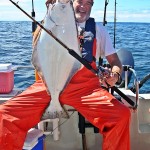 “How deep do I have to fish?” It’s one of the most frequently asked questions from anglers just getting into the halibut-fishing game. The first answer that comes to mind is, “As deep as necessary.” That’s not what they want to hear, but it’s as good a starting point as any when talking about searching the varied contours of the ocean floor for the Northwest’s trophy bottomfish, the Pacific halibut.
“How deep do I have to fish?” It’s one of the most frequently asked questions from anglers just getting into the halibut-fishing game. The first answer that comes to mind is, “As deep as necessary.” That’s not what they want to hear, but it’s as good a starting point as any when talking about searching the varied contours of the ocean floor for the Northwest’s trophy bottomfish, the Pacific halibut.
Many people associate halibut, especially larger halibut, with fishing the vast depths of the Pacific and its major inland waterways, using pool-cue rods, reels the size of small dogs and sinkers weighing several pounds. [KEEP READING]
Gearing Up for Halibut
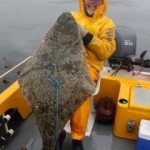 Interest in halibut fishing continues to grow here in the Pacific Northwest, so every year about this time hundreds of newcomers to the sport join thousands of halibut-fishing veterans as they flock to tackle stores and on-line shopping sites to buy rods, reels, line, terminal tackle and related equipment for their assault on the Pacific halibut, the Northwest’s trophy saltwater bottomfish.
Interest in halibut fishing continues to grow here in the Pacific Northwest, so every year about this time hundreds of newcomers to the sport join thousands of halibut-fishing veterans as they flock to tackle stores and on-line shopping sites to buy rods, reels, line, terminal tackle and related equipment for their assault on the Pacific halibut, the Northwest’s trophy saltwater bottomfish.
If you’re gearing up for your first-ever halibut season—or maybe looking to update your equipment for the first time since 1981—the most important thing to consider is HOW DEEP you’re likely to be doing most of your fishing, not HOW BIG a halibut you think you might catch. [KEEP READING]
What’s the Right Hook for Halibut?
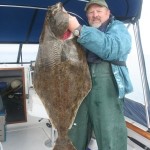 One of the great myths of the Pacific halibut fishery—and there are many—is that the circle hook is the traditional halibut hook, and because of that, some anglers think it’s the only hook to use on the halibut grounds.
One of the great myths of the Pacific halibut fishery—and there are many—is that the circle hook is the traditional halibut hook, and because of that, some anglers think it’s the only hook to use on the halibut grounds.
In fact, circle hooks are among the more recent additions to the Northwest halibut-fishing scene, first appearing in the Alaskan long-line fishery in the early 1980s after many years of proving its effectiveness in southern tuna fisheries. Bob Trumble, formerly of the International Pacific Halibut Commission, once told me that the change from J-hooks to circle hooks turned the commercial halibut fishery on its ear, causing such an increase in the long-line harvest in such a short time that scientists at first thought that halibut stocks had exploded. [KEEP READING]
How to Boat a Halibut
 Another halibut season is upon us, and it’s a safe bet that dozens-perhaps hundreds-of hefty flatties will be lost at the boat during the next few months by anglers who weren’t as prepared for halibut-fishing success as they thought they were. The Pacific halibut may not be the smartest fish in the sea, but it’s one of the strongest and toughest in this part of the country, and if you don’t have a battle plan for landing one or the equipment to carry out that plan, this fish may just beat you up and leave you wondering who really is the stupid one.
Another halibut season is upon us, and it’s a safe bet that dozens-perhaps hundreds-of hefty flatties will be lost at the boat during the next few months by anglers who weren’t as prepared for halibut-fishing success as they thought they were. The Pacific halibut may not be the smartest fish in the sea, but it’s one of the strongest and toughest in this part of the country, and if you don’t have a battle plan for landing one or the equipment to carry out that plan, this fish may just beat you up and leave you wondering who really is the stupid one.
Let’s face it, anglers down here in Washington, Oregon and northern California may not get all that many chances to hook a halibut during the course of our relatively short seasons, so when it happens, why blow it? [KEEP READING]
How to Fillet a Halibut
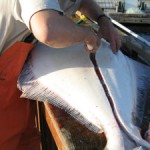
The first cut: Picture the Halibut in your mind as four sections, two on each side. The first cut is about ¼” from the backbone, the length of the Halibut. Be careful not to cut into the stomach cavity, as the bile can ruin the meat. Cutting away from your hand with your VERY sharp knife, start from the tail end, letting your knife ride across the bones. Take care to end up with the same amount of fingers you started with.
Repeat the procedure on the other side of the backbone of the halibut. If you find it easier to cut away from yourself, rotate the Halibut. [KEEP READING]
What Color for Halibut?
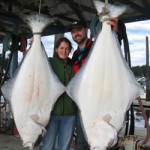 “What color you using?”
“What color you using?”
It’s one of the most commonly asked questions in the world of fishing, asked by both freshwater and saltwater anglers, whether they’re fishing for black bullheads, black rockfish or black marlin, yellow perch or yellowfin tuna. It’s as though finding out what color lure that guy in the next boat just caught his last fish on is going to transform your fishing future. Well, maybe it will, but not likely.
And the great mystery of what color to use today haunts halibut anglers just as it haunts the rest of the fishing world. Even if we have our favorites, most of us pause to consider color every time we reach into our tackle box to select a lure. [KEEP READING]
Our Favorite Halibut Recipe
 I have been told this is the same recipe that Anthony’s Seafood uses to prepare their Halibut.
I have been told this is the same recipe that Anthony’s Seafood uses to prepare their Halibut.
Marinate fillets in white wine mixed with kosher salt for 1 hour. Drain and coat each fillet with bread crumbs. Mix mayonnaise, sour cream, red onion, and fresh dill together. Spread on top of filets like frosting. Place fillets in baking dish moistened with 1 oz of white wine and 1 oz of water. Bake at 350 degrees for approximately 45 minutes (depends on how thick the fish is). Bake until the fish is just flaky in mid portion. Serves four. [KEEP READING]










